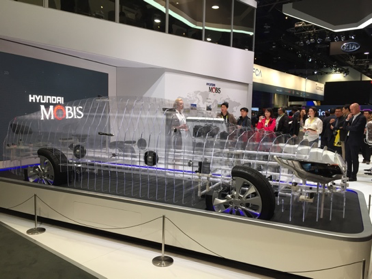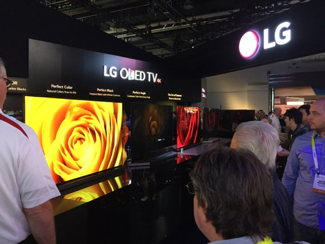Where is the semiconductor industry going in the post-smartphone era? What trends are going to shape next-generation applications and SoC development?
Just by walking around the CES show floor this year, I would say advanced visual processing technology is the horse to put money on. It was everywhere, from ADAS systems, drones, to GoPro cameras, IP cameras with embedded facial recognition, motion detectors, virtual reality, augmented reality, displays and a whole lot more.
The smartphone wars are over. And your car is your new iPhone if all the technologies demonstrated from CES come into fruition. This is classic technology evolution, not revolution.

Figure 1. The evolution of computing, from Babbage’s analytical engine, to the JOHNNIAC mainframe, IBM PC-AT, Apple iPhone, and now your new car. (Sources: Computer History Museum)
Automotive: Learning from aviation
Cars were everywhere at CES, but there are huge challenges to integrating consumer technologies into these platforms. User interface technology in automotive is the biggest hurdle here. The most promising technologies stem from aviation, including heads-up displays (HUD) and voice prompts. Visteon demonstrated a windshield HUD system that overlaid key information (like speed), supplementary information (like a map), and infrared (IR) video for obstacle avoidance. It was the slickest automobile glass cockpit I have ever seen.
Voice recognition has a long way to go based on what I saw (and heard) at CES, and driver control innovation is stagnant. I don’t expect to see a HOTAS setup in a car anytime soon.

Figure 2. A great display of automotive electronics system integration by Hyundai Mobis. (Source: Author photo)
A sore point for the human factors engineer in me is that many OEMs were offering touch screens in the car to adjust the infotainment/navigation system. This is a step backward. Touchscreens are just not as safe has having old fashioned dials because you have to look away from what’s going on outside the vehicle to make adjustments in the vehicle. That’s why aircraft cockpits have buttons, knobs and dials rather than touchscreens.
Display technology: Thin is in, and so is OLED
LG displays reigned supreme at this year’s show, with OLED models not much thicker than my iPad. If you haven’t seen an OLED display, you need to. It blows plasma and LED TVs out of the water. Screen-on-glass technology has come into its own, the most impressive example being Samsung’s transparent displays which will be great for advertising and retail. TVs are getting larger in both size and resolution, with quite a few large 8K TVs on display. These aren’t much use for consumers because of the lack of 8K content, but they will be useful commercial applications.

Figure 3. LG Electronics’ booth was packed with people gawking at their new OLED TVs.
Virtual reality: Really annoying
Many of the virtual reality-type displays at CES indicate this technology is still in its infancy. Oculus Rift was omnipresent, but there were a ton of competing companies and that could spell commoditization very quickly.
In any case, nearly a quarter of the booths had some kind of VR goggle setup as a gimmick. One VR standout was Sleep Number, the inflatable bed company, that had a booth with just carpeting and attendees sporting VR goggles. I don’t know what they were showing, but there weren’t any beds in there.
My take is that “virtual reality” as we know it today won’t be as useful as augmented reality, like the automobile HUD. You got speed readouts, information on weather and a warning when my kid chases his soccer ball right in front of your car. Theses HUDs allow you to see graphic representations what’s in front, behind and beside you so can maintain much better situational awareness. Bottom line: Ugly googles on your face are not going to change your life, but adding this technology to existing products to solve real-world problems will.
IoT is dead: Long live IoT
In addition to smart phones, the downtrend seems to encompass the so-called Internet of Things. Most IoT solutions seemed to be evolutionary such as adding moderately useless features into significantly overpriced kitchen appliances. I think the buzz around IoT has faded quickly because a killer app hasn’t emerged.
My favorite expensive solution in search of a problem was the IoT baby car seat. I don’t think we will see that thing on display again next year.
Advanced visual processing: Rise of the VPU
Everything is evolving, but the technology that first appeared in smartphones and other consumer devices is now going everywhere. This is especially true in advanced visual processing. Whether in our cars, on our TVs or somewhere else in front of our faces, expensive video processing using cheap cameras and displays will change the products we see in the future. At CES I saw lots of block diagrams with “visual processing unit (VPU)” as the key differentiating IP. Combine these VPU-heavy systems-on-chip with machine learning and we are on the way to autonomous systems that can be trained to function without constant human intervention. I don’t expect self-driving cars to be ubiquitous any time soon, but I do expect these technologies to help make new cars much safer than they are today.
SoC design and the future
One question I have is how well our “smartphone-centric” industry will adapt to these new markets. Will semiconductor companies try to sell their existing mobile architectures into these new areas, which I think is like trying to hammer a nail with a screwdriver? Or will our industry innovate and lead a new technology revolution with semiconductor companies at the forefront? Companies like Google, Ford, Apple and Tesla are not waiting for us to figure this out.



















